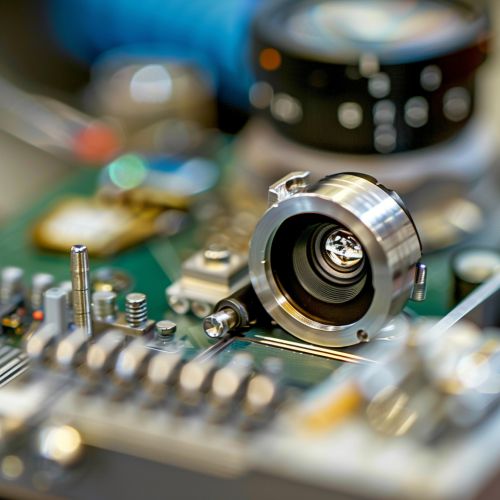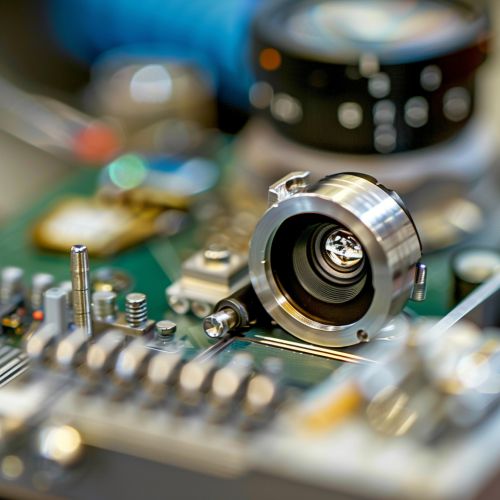Miniature Integrated Camera and Spectrometer: Difference between revisions
(Created page with "== Miniature Integrated Camera and Spectrometer == A miniature integrated camera and spectrometer is a compact device that combines imaging and spectroscopic capabilities into a single, small-scale unit. These devices are increasingly utilized in various fields such as biomedical diagnostics, environmental monitoring, and industrial applications due to their ability to provide detailed spatial and spectral information simultaneously. === Overview === Miniature integra...") |
No edit summary |
||
| Line 7: | Line 7: | ||
Miniature integrated cameras and spectrometers are designed to capture both visual images and spectral data from a scene or sample. This dual functionality allows for the analysis of the composition and properties of materials with high precision. The integration of these two technologies into a single device reduces the need for multiple instruments, making it ideal for portable and field applications. | Miniature integrated cameras and spectrometers are designed to capture both visual images and spectral data from a scene or sample. This dual functionality allows for the analysis of the composition and properties of materials with high precision. The integration of these two technologies into a single device reduces the need for multiple instruments, making it ideal for portable and field applications. | ||
[[Image:Detail-97205.jpg|thumb|center|Close-up of a miniature integrated camera and spectrometer device, showing the lens and sensor components.|class=only_on_mobile]] | |||
[[Image:Detail-97206.jpg|thumb|center|Close-up of a miniature integrated camera and spectrometer device, showing the lens and sensor components.|class=only_on_desktop]] | |||
=== Components === | === Components === | ||
Latest revision as of 08:46, 26 July 2024
Miniature Integrated Camera and Spectrometer
A miniature integrated camera and spectrometer is a compact device that combines imaging and spectroscopic capabilities into a single, small-scale unit. These devices are increasingly utilized in various fields such as biomedical diagnostics, environmental monitoring, and industrial applications due to their ability to provide detailed spatial and spectral information simultaneously.
Overview
Miniature integrated cameras and spectrometers are designed to capture both visual images and spectral data from a scene or sample. This dual functionality allows for the analysis of the composition and properties of materials with high precision. The integration of these two technologies into a single device reduces the need for multiple instruments, making it ideal for portable and field applications.


Components
Camera Module
The camera module in a miniature integrated camera and spectrometer typically includes a lens, image sensor, and processing electronics. The lens focuses light onto the image sensor, which converts the light into electrical signals. These signals are then processed to create a digital image. Modern image sensors, such as CMOS (Complementary Metal-Oxide-Semiconductor) sensors, are preferred for their low power consumption and high resolution.
Spectrometer Module
The spectrometer module is responsible for analyzing the spectral content of the light. It usually consists of a diffraction grating or a prism to disperse the light into its constituent wavelengths, a detector array to capture the dispersed light, and processing electronics to convert the detected signals into a spectrum. The spectrum provides information about the material composition and other properties of the sample.
Integration Techniques
Integrating a camera and spectrometer into a single device involves several technical challenges, including miniaturization, alignment, and calibration. Various techniques are employed to achieve this integration:
- **Micro-Optics:** The use of micro-optics, such as micro-lenses and micro-prisms, helps in reducing the size of the optical components while maintaining their functionality.
- **Monolithic Integration:** This approach involves fabricating the camera and spectrometer components on a single substrate, often using semiconductor manufacturing techniques. This method ensures precise alignment and compactness.
- **Hybrid Integration:** In hybrid integration, the camera and spectrometer modules are separately fabricated and then assembled into a single device. This allows for greater flexibility in component selection and optimization.
Applications
Miniature integrated cameras and spectrometers have a wide range of applications due to their compact size and dual functionality:
- **Biomedical Diagnostics:** These devices are used for non-invasive medical diagnostics, such as skin cancer detection and blood analysis. They provide detailed images and spectral data that help in identifying abnormalities.
- **Environmental Monitoring:** They are employed in monitoring air and water quality by detecting pollutants and contaminants. The spectral data helps in identifying specific substances and their concentrations.
- **Industrial Applications:** In industries, these devices are used for quality control and material inspection. They can detect defects and impurities in products, ensuring high standards of quality.
Advantages and Limitations
Advantages
- **Compact Size:** The integration of camera and spectrometer into a single device reduces the overall size, making it portable and easy to use in the field.
- **Cost-Effective:** Combining two functionalities into one device reduces the need for multiple instruments, lowering the overall cost.
- **Enhanced Data:** The ability to capture both spatial and spectral data simultaneously provides comprehensive information about the sample or scene.
Limitations
- **Complexity:** The integration process is technically challenging and requires precise alignment and calibration.
- **Limited Spectral Range:** Miniaturization may limit the spectral range and resolution compared to larger, standalone spectrometers.
- **Power Consumption:** Although modern sensors are energy-efficient, the combined operation of camera and spectrometer modules can lead to higher power consumption.
Future Developments
Research and development in the field of miniature integrated cameras and spectrometers are focused on improving their performance and expanding their applications. Some of the key areas of development include:
- **Enhanced Sensitivity:** Improving the sensitivity of detectors to capture low-intensity light and weak spectral signals.
- **Broader Spectral Range:** Extending the spectral range to cover more wavelengths, including ultraviolet and infrared regions.
- **Advanced Algorithms:** Developing sophisticated algorithms for data processing and analysis to extract more information from the captured data.
- **Wireless Connectivity:** Integrating wireless communication capabilities for remote monitoring and data transmission.
